Hi everyone!.
I want to replace a seas p21rf and I already own a p21rex pair (new old stock, never used before) so I am tempted to change the 20 years old drivers for the new one.
Crossover wise, will the new driver work with old crossover? They share many similar specs and Seas states that p21rf is a further development of the p21rex but with 2inch voice coil, also I like the sound of p21rex, it is more sensitive speaker so it works better for me
I want to replace a seas p21rf and I already own a p21rex pair (new old stock, never used before) so I am tempted to change the 20 years old drivers for the new one.
Crossover wise, will the new driver work with old crossover? They share many similar specs and Seas states that p21rf is a further development of the p21rex but with 2inch voice coil, also I like the sound of p21rex, it is more sensitive speaker so it works better for me
Attachments
Curious to know the answer to this as well. I have a pair of p21re and they are such great drivers. Wish they still made them.
No.
You will need a new crossover.
Once you make a new low pass, you will at least have to change the attenuation on the high pass, probably more, probably enough more that you are better off starting with a clean sheet, rather than add more bandaids.
Of course, you could throw one in and see if you don't hate it.
You will need a new crossover.
Once you make a new low pass, you will at least have to change the attenuation on the high pass, probably more, probably enough more that you are better off starting with a clean sheet, rather than add more bandaids.
Of course, you could throw one in and see if you don't hate it.
I would just try it!
A few old SEAS drivers still around: Seas P21RE/P H0942-08 Woofer. H0313 2015 remake
You might make some guesses about acoustic loading. The above is more of a closed box driver around 0.51 Qts. Reflex is nearer 0.38 Qts usually.
Adjusting tweeter level is usually a question of adjusting an ohm or two at the tweeter input crossover. But I have swapped 8" bass units often enough. They usually work OK.
A few old SEAS drivers still around: Seas P21RE/P H0942-08 Woofer. H0313 2015 remake
You might make some guesses about acoustic loading. The above is more of a closed box driver around 0.51 Qts. Reflex is nearer 0.38 Qts usually.
Adjusting tweeter level is usually a question of adjusting an ohm or two at the tweeter input crossover. But I have swapped 8" bass units often enough. They usually work OK.
Last edited:
I am a noob at crossover designs, and I've never seen a design like this. This is the Tweeter crossover design. Too many resistors...
Six resistors 10w 10.7ohm
Six resistors 10w 10.7ohm
Attachments
Last edited:
Well you won't do any harm swapping woofers (replacing RFP with REX) as they have very similar impedance profiles.
However, the REX looks to be ~ 2 - 3dB more sensitive? and has cone breakup to deal with?
You might find the midbass / lower midrange a bit bloated and there could be some nasal / forwardness in the lower treble without attenuating the breakup.
I'm guessing the tweeter is probably crossed higher? so the breakup will likely need to be dealt with.
Best thing to do is plug your current speaker crossover and factory curves (traced) into a simulator. It doesn't matter that they don't include the actual measured drivers, since what you are trying to do is alter the crossover to replicate the FR response with the REX in place. That's what I'd do.
However, the REX looks to be ~ 2 - 3dB more sensitive? and has cone breakup to deal with?
You might find the midbass / lower midrange a bit bloated and there could be some nasal / forwardness in the lower treble without attenuating the breakup.
I'm guessing the tweeter is probably crossed higher? so the breakup will likely need to be dealt with.
Best thing to do is plug your current speaker crossover and factory curves (traced) into a simulator. It doesn't matter that they don't include the actual measured drivers, since what you are trying to do is alter the crossover to replicate the FR response with the REX in place. That's what I'd do.
You'll have to roll your sleeves up and draw the schematic to figure out what to adjust!
You might find this thread helpful:
Restoring Monitor Audio R300 bookshelf speakers.
These things usually end up like this:

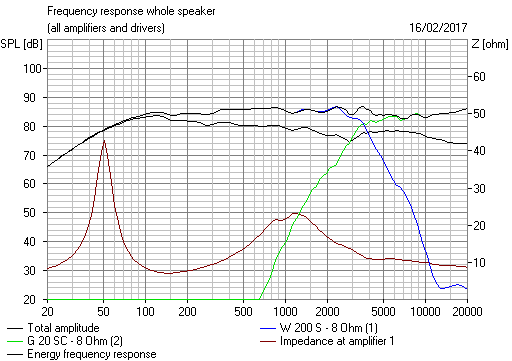
You might find this thread helpful:
Restoring Monitor Audio R300 bookshelf speakers.
These things usually end up like this:
Looking at SEAS here:
http://www.seas.no/images/stories/vintage/pdfdataheet/h0511_p21rfp.pdf
http://www.seas.no/images/stories/vintage/pdfdataheet/h0282_p21rex.pdf
Not much in it! Both reflex drivers. REX a bit louder and brighter at the top than the old RFP one. That won't be hard to correct. Maybe a bigger bafflestep coil, or maybe a bigger shunt capacitor. Maybe reduce resistance at the tweeter input to make tweeter louder.
Have a go. Nothing will break!
http://www.seas.no/images/stories/vintage/pdfdataheet/h0511_p21rfp.pdf
http://www.seas.no/images/stories/vintage/pdfdataheet/h0282_p21rex.pdf
Not much in it! Both reflex drivers. REX a bit louder and brighter at the top than the old RFP one. That won't be hard to correct. Maybe a bigger bafflestep coil, or maybe a bigger shunt capacitor. Maybe reduce resistance at the tweeter input to make tweeter louder.
Have a go. Nothing will break!
Thanks everybody for your time!
I tried the p21rex without changing anything and I liked the sound a lot. It seems it is crossed at a low frequency point so no cone break up and nothing annoying. The p21rex drivers have more bass than the p21rf, so it sounds better to me. I tried to draw the crossover schematic but the coils didn't have any number on them. So I cannot tell how many mh they are.
Ι uploaded a picture of the cross just for reference.
On the right is the midbass section
I tried the p21rex without changing anything and I liked the sound a lot. It seems it is crossed at a low frequency point so no cone break up and nothing annoying. The p21rex drivers have more bass than the p21rf, so it sounds better to me. I tried to draw the crossover schematic but the coils didn't have any number on them. So I cannot tell how many mh they are.
Ι uploaded a picture of the cross just for reference.
On the right is the midbass section
Attachments
I am a noob at crossover designs, and I've never seen a design like this. This is the Tweeter crossover design. Too many resistors...
Six resistors 10w 10.7ohm
Only a small image here, since your original is unnecessarily huge!
Hmm, I only see three ceramic resistors. You'd think the bass section is on the left and is a bass bafflestep coil, with a shunt of ceramic 5.35 ohm (parallel 10W types) and a biggish capacitance consisting of three MKP capacitors.
The tweeter section, on the right, is a bit peculiar. Two coils, three varied capacitors and a level-adjusting resistor. I can't quite make sense of that. Something quite sophisticated conceivably:
The yellow 0.82uF capacitor could only have a use as a bit of very high frequency rolloff on the tweeter. Usually with about 7.5 ohms, aka a Zobel.
But overall, looks like the bass section is quite simple, and hence forgiving of precise details. IMO, 8" woofers are fairly interchangeable! The reason I often mark the input resistor on the tweeter section in red, is it is adjustable to taste.
Steve, sorry for the huge picture!
I woke up early this morning and I took another look at the crossover. Both of those boards are for the midbass section. I followed the cables and found another board for the Tweeter!. I felt like a completely fool!
At the midbass section the left board has six resistors and three mkt caps 8.2uf each and the coil. At the right board there is the large coil, a 6.8uf mkt cap, the 0.82uf cap, an orange cap and a resistor!.
At the Tweeter board a murdof 6.8uf and a mkt 2.2uf
I woke up early this morning and I took another look at the crossover. Both of those boards are for the midbass section. I followed the cables and found another board for the Tweeter!. I felt like a completely fool!
At the midbass section the left board has six resistors and three mkt caps 8.2uf each and the coil. At the right board there is the large coil, a 6.8uf mkt cap, the 0.82uf cap, an orange cap and a resistor!.
At the Tweeter board a murdof 6.8uf and a mkt 2.2uf
Attachments
Last edited:
vassilis1984,
a pleasure talking to you.
I think most people here just love music. Which has led us to explore good sound at home. I know I have. Maybe even learned to DANCE like Zorba. 😀
I thought we were adjusting a two-way here:
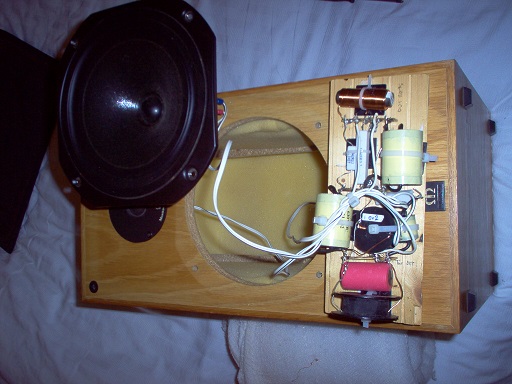
This sort of thing:
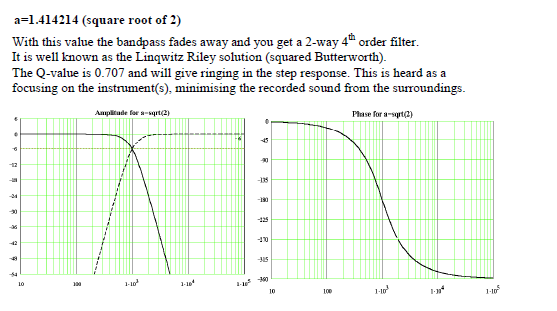

But I am starting to think you have a three way like my 45 year old Celestion Ditton 44:
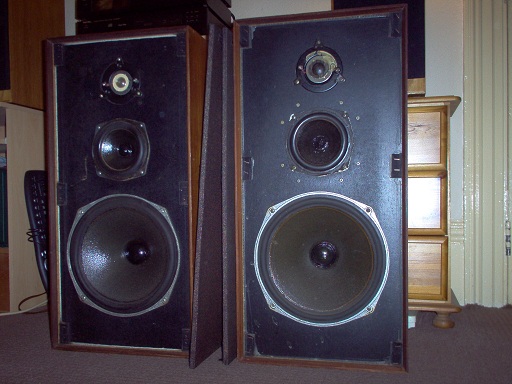
These use a more complex filter:
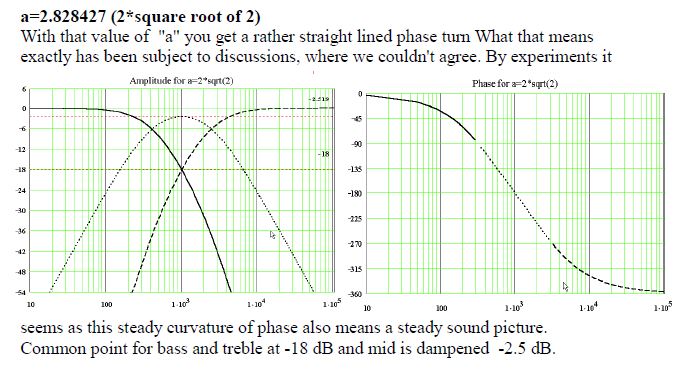
This sort of thing:
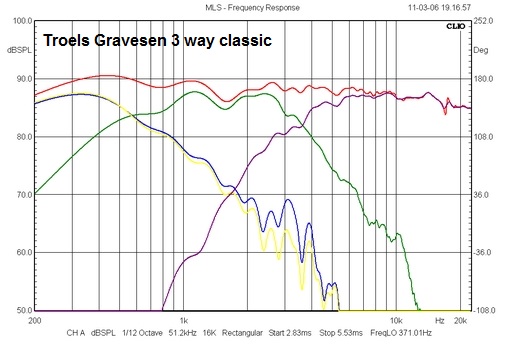
SEAS-3-Way-Classic
If you want to try speaker simulation, this one is useful:
Software | Visaton
Some simple projects you can put in the projekte folder and explore:
2 Wege – Boxsim Projektdatenbank
A huge archive of good designs here too:
Crossover Design Archives - Madisound Speaker PDF Library
Welcome to the hobby! Where there is a symmetry, there is a conservation law. In our case it tends to be (but not always) frequency response that is conserved.
Emmy Noether proved that!
Clever stuff. Noether's Theorem is also the basis of Quantum Field Theory. 😎
a pleasure talking to you.
I think most people here just love music. Which has led us to explore good sound at home. I know I have. Maybe even learned to DANCE like Zorba. 😀
I thought we were adjusting a two-way here:
This sort of thing:
But I am starting to think you have a three way like my 45 year old Celestion Ditton 44:

These use a more complex filter:
This sort of thing:
SEAS-3-Way-Classic
If you want to try speaker simulation, this one is useful:
Software | Visaton
Some simple projects you can put in the projekte folder and explore:
2 Wege – Boxsim Projektdatenbank
A huge archive of good designs here too:
Crossover Design Archives - Madisound Speaker PDF Library
Welcome to the hobby! Where there is a symmetry, there is a conservation law. In our case it tends to be (but not always) frequency response that is conserved.
Emmy Noether proved that!
Clever stuff. Noether's Theorem is also the basis of Quantum Field Theory. 😎
Last edited:
It is a two way speaker!.
An Greek brand named audio spectrum and the model is s37 (37 stands for the liters of the cabin.)
The left board, as you can see at the picture has only one input. The red/black wires are getting in the board but I don't see red/black wire to getting out. I don't know what kind of sorcery this is.
The little board I discovered yesterday is for sure the Tweeter crossover. The other two are the midbass section.
I uploaded also a picture of the speakers. 8inch 2-way!.
An Greek brand named audio spectrum and the model is s37 (37 stands for the liters of the cabin.)
The left board, as you can see at the picture has only one input. The red/black wires are getting in the board but I don't see red/black wire to getting out. I don't know what kind of sorcery this is.
The little board I discovered yesterday is for sure the Tweeter crossover. The other two are the midbass section.
I uploaded also a picture of the speakers. 8inch 2-way!.
Attachments
I see no alternative to tracing what is connected to what, if it interests you.
I dug into this Wharfedale Shelton XP2:


I got quite a headache:
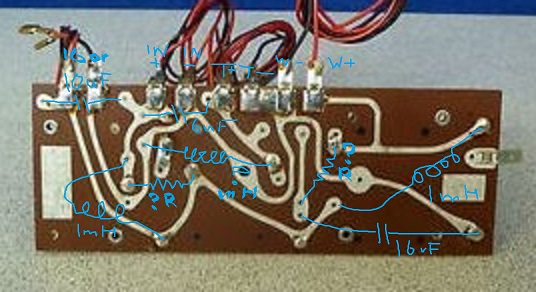
Came out to this, which I simmed out of interest:
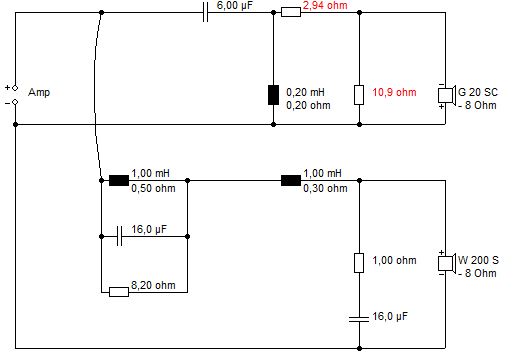
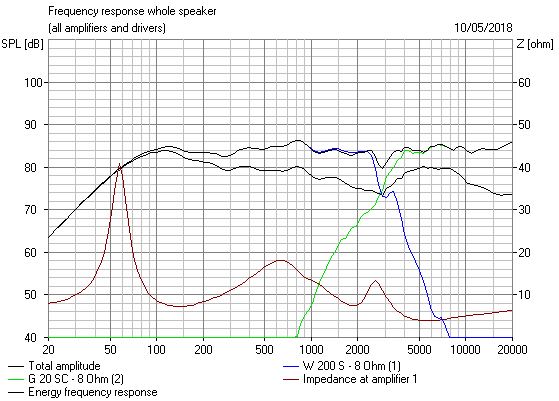
I dug into this Wharfedale Shelton XP2:
I got quite a headache:
Came out to this, which I simmed out of interest:
A little update, this is the schematic of the crossover, I guess that I have to remove any phase correction circuit, also the frequency response looks similar, but p21rex has some serious break up.
The resistor at the lcr circuit according to the calculator are 1r7 (six resistors in series)
By the way it sounds good, but as Dave Bullet said there is some nasal / forwardness in the lower treble without attenuating the break up
The resistor at the lcr circuit according to the calculator are 1r7 (six resistors in series)
By the way it sounds good, but as Dave Bullet said there is some nasal / forwardness in the lower treble without attenuating the break up
Attachments
- Home
- Loudspeakers
- Multi-Way
- Drop In replacement for seas woofer









